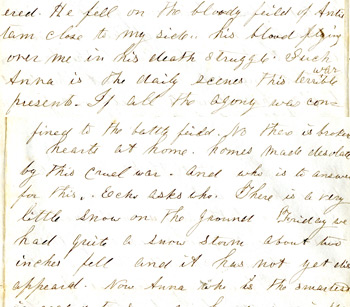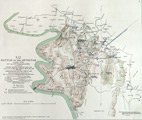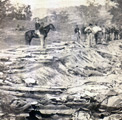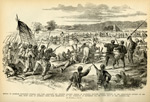Click Center Image for Full Size Picture
On September 17, 1862, one of the first major battles on Northern soil took place near Sharpsburg, Maryland, and Antietam Creek. The Battle of Antietam was the bloodiest single-day encounter in American history with over 23,000 casualties. After his victory at Manassas in August 1862, General Robert E. Lee marched his Army of Northern Virginia, consisting of approximately forty thousand soldiers, into Maryland. Lee's Maryland Campaign was the South's invasion of the North. Not only was Lee seeking much needed soldiers and supplies, but also a strong show of force that could lead to possible foreign intervention in support of the South.
In his letter dated September 7, 1862, from near Rockville, Maryland, Abial Edwards told Anna Conant that "it is sad to think that they [Lee's forces] have entered Maryland but so it is[.] they have crossed but a few miles above us with a heavy force estimated at 60,000 and now are comeing [sic] this way." In the same letter, Edwards continued to tell Anna that "in a short time our little regiment will in all probability be in hard battle but we are ready for them. The boy's are all waiting with determination to fight and to conquer or die. For defeat here would be worse than death."
Major General George B. McClellan's Army of the Potomac, including Abial Edwards's company, was eighty-seven thousand strong and set out to intercept Lee's forces.Point of Rocks, Maryland.
They went first to Frederick, Maryland, then to the passes of South Mountain. By September 15, both armies had established battle lines west and east of Antietam Creek near the town of Sharpsburg, Maryland. At dawn on September 17, General Joseph Hooker's troops mounted a powerful first Union assault on Lee's army. Roused from their slumber, Edwards's company marched toward the sound of firing and moved into an open field east of the Miller Farm to form an arch behind Hooker's corps. Attacks and counterattacks followed, sweeping across Miller's cornfield and the Dunker Church and continuing at the Sunken Road. Later in the day, Union Major General Ambrose Burnside's forces crossed the stone bridge over Antietam Creek. His forces met Confederate Major General Ambrose Powell Hill's division who had arrived from Harpers Ferry to reinforce Southern troops. The counterattack drove Burnside's forces back.
At the end of the battle neither side had won a decisive victory. Although Lee was outnumbered two-to-one, he committed his entire force to the battle, whereas McClellan sent in less than three-quarters of his army. This would be the last battle of McClellan's military career. Lee's failure to carry the war into the North was significant—it caused Great Britain to postpone recognition of the Confederate government. The battle also gave President Abraham Lincoln the opportunity to issue the preliminary Emancipation Proclamation, which, on January 1, 1863, declared all slaves in the Confederate states free.






